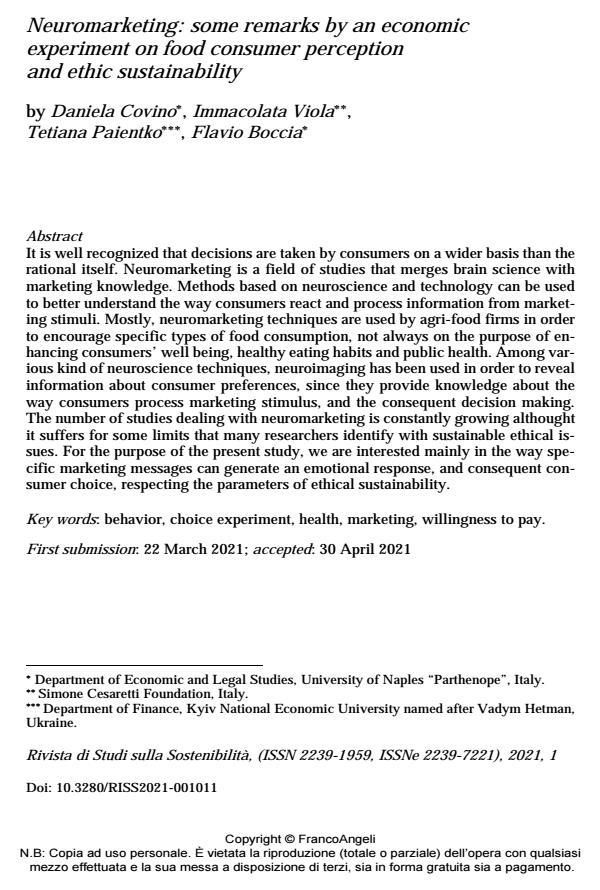Neuromarketing: some remarks by an economic experiment on food consumer perception and ethic sustainability
Titolo Rivista RIVISTA DI STUDI SULLA SOSTENIBILITA'
Autori/Curatori Daniela Covino, Immacolata Viola, Tetiana Paientko, Flavio Boccia
Anno di pubblicazione 2021 Fascicolo 2021/1
Lingua Inglese Numero pagine 13 P. 187-199 Dimensione file 97 KB
DOI 10.3280/RISS2021-001011
Il DOI è il codice a barre della proprietà intellettuale: per saperne di più
clicca qui
Qui sotto puoi vedere in anteprima la prima pagina di questo articolo.
Se questo articolo ti interessa, lo puoi acquistare (e scaricare in formato pdf) seguendo le facili indicazioni per acquistare il download credit. Acquista Download Credits per scaricare questo Articolo in formato PDF

FrancoAngeli è membro della Publishers International Linking Association, Inc (PILA)associazione indipendente e non profit per facilitare (attraverso i servizi tecnologici implementati da CrossRef.org) l’accesso degli studiosi ai contenuti digitali nelle pubblicazioni professionali e scientifiche
It is well recognized that decisions are taken by consumers on a wider basis than the rational itself. Neuromarketing is a field of studies that merges brain science with marketing knowledge. Methods based on neuroscience and technology can be used to better understand the way consumers react and process information from marketing stimuli. Mostly, neuromarketing techniques are used by agri-food firms in order to encourage specific types of food consumption, not always on the purpose of enhancing consumers’ well being, healthy eating habits and public health. Among various kind of neuroscience techniques, neuroimaging has been used in order to reveal information about consumer preferences, since they pro-vide knowledge about the way consumers process marketing stimulus, and the consequent decision making. The number of studies dealing with neuromarketing is constantly growing althought it suffers for some limits that many researchers identify with sustainable ethical issues. For the purpose of the present study, we are interested mainly in the way specific marketing messages can generate an emo-tional response, and consequent consumer choice, respecting the parameters of ethical sustainability.
- Neuromarketing: Strategies for Visual Perception in Predicting Consumer Behavior Mauricio Quisimalin Santamaria, Alice Garzón Moantaguano, Anabel Parra Jiménez, in Estudios de la Gestión: Revista Internacional de Administración /2025 pp.59
DOI: 10.32719/25506641.2025.18.3 - Neuroscientific Insights and Therapeutic Approaches to Eating Disorders Nitish Kumar Minz, Indira Bhardwaj, Anshika Prakash, Monika Yadav, pp.101 (ISBN:9798369332306)
- How Investors’ Financial Well-being Influences Enterprises and Individual’s Psychological Fitness? Moderating Role of Experience under Uncertainty Bijay Prasad Kushwaha, Atul Shiva, Vikas Tyagi, in Sustainability /2023 pp.1699
DOI: 10.3390/su15021699 - Metaverse, the last technological frontier of environmental sustainable food: Worldwide evidence from the first business case studies Flavio Boccia, Joanna Rosak-Szyrocka, Houman Hashemzadeh, Daniela Covino, in RIVISTA DI STUDI SULLA SOSTENIBILITA' 1/2023 pp.153
DOI: 10.3280/RISS2023-001009
Daniela Covino, Immacolata Viola, Tetiana Paientko, Flavio Boccia, Neuromarketing: some remarks by an economic experiment on food consumer perception and ethic sustainability in "RIVISTA DI STUDI SULLA SOSTENIBILITA'" 1/2021, pp 187-199, DOI: 10.3280/RISS2021-001011